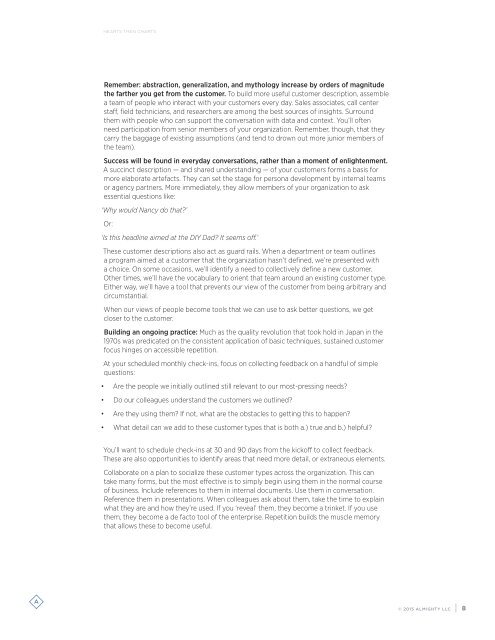Hearts then Charts
Almighty_HeartThenCharts_2015
Almighty_HeartThenCharts_2015
You also want an ePaper? Increase the reach of your titles
YUMPU automatically turns print PDFs into web optimized ePapers that Google loves.
HEARTS THEN CHARTS<br />
Remember: abstraction, generalization, and mythology increase by orders of magnitude<br />
the farther you get from the customer. To build more useful customer description, assemble<br />
a team of people who interact with your customers every day. Sales associates, call center<br />
staff, field technicians, and researchers are among the best sources of insights. Surround<br />
them with people who can support the conversation with data and context. You’ll often<br />
need participation from senior members of your organization. Remember, though, that they<br />
carry the baggage of existing assumptions (and tend to drown out more junior members of<br />
the team).<br />
Success will be found in everyday conversations, rather than a moment of enlightenment.<br />
A succinct description — and shared understanding — of your customers forms a basis for<br />
more elaborate artefacts. They can set the stage for persona development by internal teams<br />
or agency partners. More immediately, they allow members of your organization to ask<br />
essential questions like:<br />
‘Why would Nancy do that?’<br />
Or:<br />
‘Is this headline aimed at the DIY Dad? It seems off.’<br />
These customer descriptions also act as guard rails. When a department or team outlines<br />
a program aimed at a customer that the organization hasn’t defined, we’re presented with<br />
a choice. On some occasions, we’ll identify a need to collectively define a new customer.<br />
Other times, we’ll have the vocabulary to orient that team around an existing customer type.<br />
Either way, we’ll have a tool that prevents our view of the customer from being arbitrary and<br />
circumstantial.<br />
When our views of people become tools that we can use to ask better questions, we get<br />
closer to the customer.<br />
Building an ongoing practice: Much as the quality revolution that took hold in Japan in the<br />
1970s was predicated on the consistent application of basic techniques, sustained customer<br />
focus hinges on accessible repetition.<br />
At your scheduled monthly check-ins, focus on collecting feedback on a handful of simple<br />
questions:<br />
• Are the people we initially outlined still relevant to our most-pressing needs?<br />
• Do our colleagues understand the customers we outlined?<br />
• Are they using them? If not, what are the obstacles to getting this to happen?<br />
• What detail can we add to these customer types that is both a.) true and b.) helpful?<br />
You’ll want to schedule check-ins at 30 and 90 days from the kickoff to collect feedback.<br />
These are also opportunities to identify areas that need more detail, or extraneous elements.<br />
Collaborate on a plan to socialize these customer types across the organization. This can<br />
take many forms, but the most effective is to simply begin using them in the normal course<br />
of business. Include references to them in internal documents. Use them in conversation.<br />
Reference them in presentations. When colleagues ask about them, take the time to explain<br />
what they are and how they’re used. If you ‘reveal’ them, they become a trinket. If you use<br />
them, they become a de facto tool of the enterprise. Repetition builds the muscle memory<br />
that allows these to become useful.<br />
© 2015 ALMIGHTY LLC | 8


